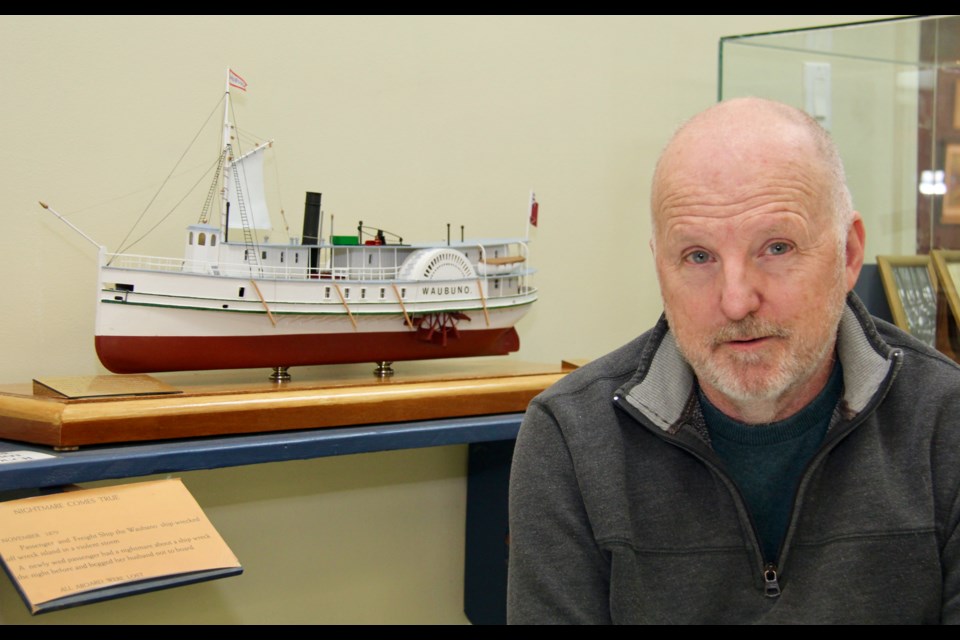The sinking of the Waubuno on Georgian Bay November 22, 1879 remains a mystery.
More than 20 aboard the wooden, side-wheel paddle steamer perished when the ship capsized near what is now called Wreck Island. The cause of the sinking was never determined and there was no passenger manifest onshore.
“No bodies were ever found,” said non-fiction author and historian Douglas Hunter, who has been obsessed with the ship for the past 16 years.
An avid boater, Hunter has snorkelled around the ship's remains. He’s also spent dozens of eye-drying hours scouring microfilms of old newspaper articles and archival materials near and far to understand the ship, its people and the politics of the era.
The Port McNicoll resident is endeavouring to complete and publish a book on the subject, so he can get some rest.
“I have to stop turning over stones,” he said during an interview at the Huronia Museum, which has the rudder, a black and white photograph and a model of the Waubuno on display.
The 135-foot ship was built in 1865 on the Beatty sawmill property in Thorold by J. and W. Beatty and Company for their lumber business in Parry Sound. It was later owned by the Georgian Bay Transportation Company to ferry passengers and goods from the Northern Railway’s railhead in Collingwood to Parry Sound and Sault Ste. Marie.
At the time of its service on Georgian Bay and Lake Huron, John A. MacDonald, Canada’s first prime minister was in power. Cars had not yet been invented so people depended on ships for travel where there wasn’t a train. Communities around Georgian Bay were growing and needed supplies, so ships were worked hard, said Hunter.
On the day it sank, the ship was carrying people and goods from Collingwood to Parry Sound.
The Waubuno’s sinking was a huge controversy in its day that led to a "legal marathon," said Hunter.
The widow of Baptist Fisher, who died onboard, sued the ship owners for negligence in a civil trial, but it resulted in a hung jury, 11-1, where unanimity was required.
A second court case also resulted in a hung jury. A hung jury in both trials meant that there was no judgment. Without a judgment, it didn’t make it into case law, said Hunter, who holds a PhD in history.
Hunter found articles about the trials in the former Toronto Globe newspaper.
“A lot of archival work had to be done. Nobody had ever looked at the trials. It was a gold mine of information because there were so many witnesses who testified," Hunter said.
“This whole world suddenly blooms in front of you that you couldn’t get otherwise,” he said.
Hunter said he found the whole experience to exemplify the deeply partisan lines in place at the time in terms of politics, religion and ethnicity and allegiances built on those lines. There was no government inquiry into the sinking of the Waubuno.
Weather data was being collected by local people and submitted to the Canadian Meteorological Service. Hunter secured scanned original data sheets and used that to build a picture of the weather that day.
“That day was very cold. There was ice in the harbour. The weather came in from the south-east and switched to the south-west," he said. He hazards a guess that the waves were between five and six feet.
“It should have been a survivable day,” believes Hunter. “If the ship went down in open water, that says something about its sea worthiness.” That was the position of Emma Fisher’s lawyers.
The company’s position was that the ship hit rocks unseen in a snow storm and called it an “act of God.”
Hunter believes there could have been coercion with the jurors.
“Most everyone who testified for the defence had some connection to the company,” he said.
The Waubuno was the lead-in to more shipping disasters. When the Asia steamer, also owned by the Georgian Bay Transportation Company, sunk in 1882, all but two of the more than 120 people on board died. In this case, there were bodies found and two coroner’s inquests were held.
"After the Asia, the federal MacDonald government brought in many crucial reforms for ship safety for the Great Lakes."
Hunter is the author of more than 20 books. His most recent is Jackson’s Wars: A.Y. Jackson, the Birth of the Group of Seven, and the Great War, published in 2022. It is available for sale at all books stores including Georgian Bay Books in Midland.
An exhibition Jackson’s Wars: A.Y. Jackson before the Group of Seven will be held at the McMichael Canadian Art Collection gallery in Kleinburg is provisionally opening May 25. Hunter is curating the exhibition.
For more information about Douglas Hunter, visit his website.



